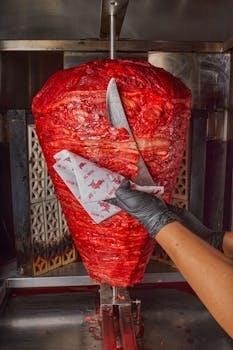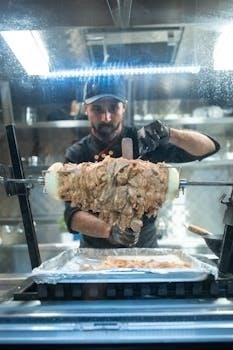Embark on a culinary journey! This guide unveils expert meat-slicing techniques, ensuring professional-looking results at home. Discover the importance of sharp knives, proper techniques, and understanding different meat types. Unlock the full potential of your meat-slicing endeavors with our comprehensive guide.
Importance of Slicing Meat Correctly
Slicing meat correctly is paramount for several reasons, extending beyond mere aesthetics. It significantly impacts the tenderness and flavor of the meat, ultimately enhancing the dining experience. Proper slicing ensures uniform cuts, which promotes even cooking and consistent texture throughout the dish.
Moreover, the way meat is sliced can dramatically affect its palatability. Slicing against the grain, for instance, shortens the muscle fibers, making the meat easier to chew and more tender. This technique is particularly crucial for tougher cuts of meat.
Furthermore, correct slicing techniques are essential for maximizing flavor absorption. Thin, even slices allow marinades and sauces to penetrate the meat more effectively, resulting in a more flavorful and aromatic dish. The visual appeal of sliced meat also plays a role, as neatly sliced portions are more appetizing and presentable;
In essence, mastering the art of meat slicing is a fundamental skill for any home cook or professional chef. By understanding the principles of proper slicing, one can elevate the quality and enjoyment of meat-based meals; From enhancing tenderness to maximizing flavor, the importance of correct meat slicing cannot be overstated.
Essential Tools⁚ Knives and Slicers

Achieving perfectly sliced meat requires the right tools. While a skilled hand can work wonders, having quality knives and slicers is essential for consistent results. The primary tool is a sharp knife, preferably a slicing knife with a long, thin blade. This design allows for smooth, even cuts without tearing the meat.
A honing steel is another crucial tool, used to maintain the knife’s sharpness by realigning the blade’s edge. For those seeking ultimate precision and efficiency, a meat slicer is invaluable. These machines offer adjustable thickness settings, enabling uniform slices for deli meats, charcuterie boards, and more.
When selecting a meat slicer, consider both electric and manual options. Electric slicers provide effortless slicing with consistent results, while manual slicers offer greater control and are suitable for smaller tasks. A sturdy cutting board is also essential, providing a stable surface for slicing and protecting your countertops.
In summary, the essential tools for meat slicing include a sharp slicing knife, a honing steel, and optionally, a meat slicer. Investing in quality tools will significantly improve your slicing technique and the overall quality of your meat dishes.
Knife Selection⁚ Types and Uses
Choosing the right knife is paramount for successful meat slicing. The chef’s knife, also known as a French knife, is a versatile option for general-purpose chopping, slicing, and dicing. Its broad blade and curved edge allow for efficient rocking motions. However, for more precise slicing, specialized knives are preferred.
A slicing knife, characterized by its long, thin blade, is ideal for carving roasts and slicing cooked meats. Its length enables smooth, even cuts across large surfaces. Slicing knives often feature grantons, or hollowed-out grooves, along the blade to prevent meat from sticking.
A boning knife, with its narrow, flexible blade, is designed for removing bones from raw meat. Its maneuverability allows for precise cuts around joints and bones. A utility knife, smaller than a chef’s knife, is suitable for smaller tasks such as trimming fat or slicing smaller cuts of meat.
Ultimately, the best knife for meat slicing depends on the specific task and personal preference. A sharp, well-maintained knife is crucial, regardless of the type. Understanding the different types of knives and their intended uses will significantly enhance your meat slicing skills.
Slicing Techniques⁚ Rocking, Pulling, and Pushing
Mastering various slicing techniques is essential for achieving desired results. The rocking motion, ideal for chopping vegetables and herbs, involves placing one hand on the knife handle while using the other to guide the blade. A gentle rocking motion allows for controlled, even cuts.
Slicing, a versatile technique, involves cutting ingredients into thin, uniform pieces. Position the ingredient firmly and use a smooth, downward motion with the knife. Maintain a consistent angle for even slices. The pulling technique is often used for slicing cooked meats. With the blade angled slightly towards you, pull the knife through the meat, creating thin, even slices.
The pushing technique, conversely, involves pushing the knife away from you. This is often preferred for slicing raw meats, as it provides more control and reduces the risk of tearing. Regardless of the technique, a sharp knife is crucial for clean, precise cuts. Practice each technique to determine which works best for different types of meat and desired slice thickness. Proper technique ensures consistent results and enhances the presentation of your dishes.
Slicing Against the Grain⁚ Why and How

Slicing against the grain is a crucial technique for tenderizing meat and enhancing its flavor; The “grain” refers to the direction of the muscle fibers in the meat. When you slice with the grain, you’re essentially cutting parallel to these fibers, resulting in chewier, tougher pieces.

Slicing against the grain, however, shortens these muscle fibers, making the meat significantly more tender and easier to chew. To identify the grain, look for the lines running along the surface of the meat. Position the meat so that the grain runs perpendicular to your knife.
Using a sharp knife, cut across the grain at a 90-degree angle. This effectively shortens the muscle fibers, breaking them down and creating a more tender texture. Slicing against the grain is particularly important for tougher cuts of meat, such as flank steak or skirt steak. By mastering this technique, you can transform even the most economical cuts into delicious, tender meals; Remember to always use a sharp knife and a steady hand for best results.
Slicing Different Meats⁚ Beef, Pork, Poultry
Each type of meat possesses unique characteristics that demand specific slicing approaches. For beef, identifying the grain is paramount, especially with cuts like flank or skirt steak. Always slice against the grain to maximize tenderness. For roasts, consider resting the meat before slicing to retain juices.
Pork, often denser than beef, benefits from thin slicing, particularly for preparations like stir-fries or sandwiches. A sharp knife and consistent pressure are key. Poultry, with its varied textures, requires careful handling. For breasts, slice on a slight bias for even cooking and presentation. For legs and thighs, consider deboning before slicing for easier serving.
Remember, poultry must be cooked to a safe internal temperature. Adjust slicing thickness based on the intended use. Thicker slices work well for standalone dishes, while thinner slices are ideal for layering or incorporating into other recipes. Mastering these nuances elevates the dining experience and unlocks the full potential of each meat.
Achieving Thin Slices⁚ Tips and Tricks
Mastering the art of thin slicing elevates your culinary creations, from deli-style sandwiches to delicate Asian-inspired dishes. A razor-sharp knife is your greatest ally. Ensure your knife is properly sharpened before each slicing session, maintaining a consistent angle for uniform results.
Chilling the meat beforehand can significantly improve its firmness, making it easier to slice thinly. Consider placing the meat in the freezer for 30-60 minutes before slicing. This firms up the meat without freezing it solid, allowing for cleaner, more precise cuts. A meat slicer can be a worthwhile investment for those who frequently require thin slices.
When slicing manually, employ a gentle sawing motion, applying consistent pressure while guiding the knife. Avoid pressing down forcefully, as this can tear the meat. For tougher cuts, slicing against the grain is even more crucial to ensure tenderness. Practice makes perfect, so don’t be discouraged if your first attempts aren’t flawless. With time and patience, you’ll achieve consistently thin and beautiful slices.
Safety Tips for Using Meat Slicers

Operating a meat slicer demands utmost caution. Always prioritize safety to prevent accidents. Before using the slicer, thoroughly read and understand the manufacturer’s instructions. Never operate the slicer if you are feeling tired or distracted. Ensure the slicer is placed on a stable, non-slip surface.
Keep your fingers away from the blade at all times. Use the provided food carriage and pusher to guide the meat. Never attempt to slice meat freehand. Wear cut-resistant gloves for an added layer of protection. Turn off and unplug the slicer before cleaning or making any adjustments.
When cleaning, be extremely careful around the blade. Use a brush or cloth, never your bare hands; Store the slicer in a safe place, out of reach of children. Regularly inspect the slicer for any signs of damage. If you notice any problems, discontinue use and consult a qualified technician. By following these safety tips, you can enjoy the convenience of a meat slicer without compromising your well-being.
Resting Meat Before Slicing
Resting meat after cooking is a crucial step often overlooked, but it significantly impacts the final texture and flavor. Allowing the meat to rest allows the juices, driven to the center during cooking, to redistribute throughout the cut. This results in a more tender and flavorful slice.
When meat is heated, the muscle fibers contract and squeeze out moisture. Resting allows these fibers to relax and reabsorb the expelled juices. The resting period also helps to equalize the temperature within the meat, preventing a dry outer layer and a rare center.
The ideal resting time varies depending on the size and type of meat. A general rule of thumb is to rest larger cuts, like roasts, for 15-20 minutes, while smaller cuts, like steaks, can rest for 5-10 minutes. Tent the meat loosely with foil to keep it warm without steaming it. Slicing meat immediately after cooking results in a significant loss of juices, leading to a drier, less palatable result.
